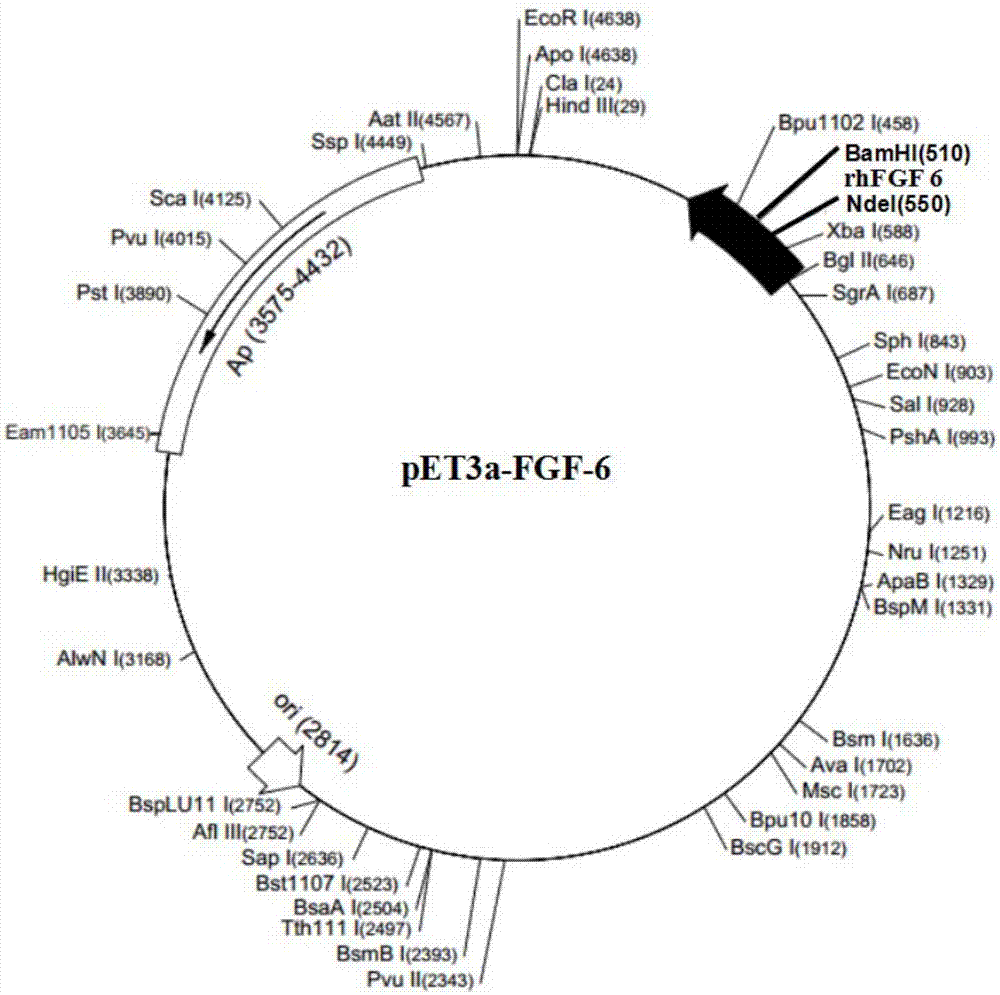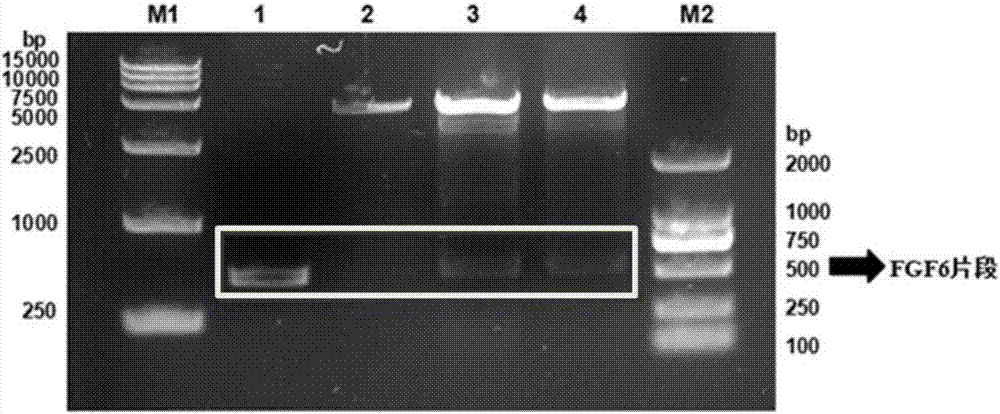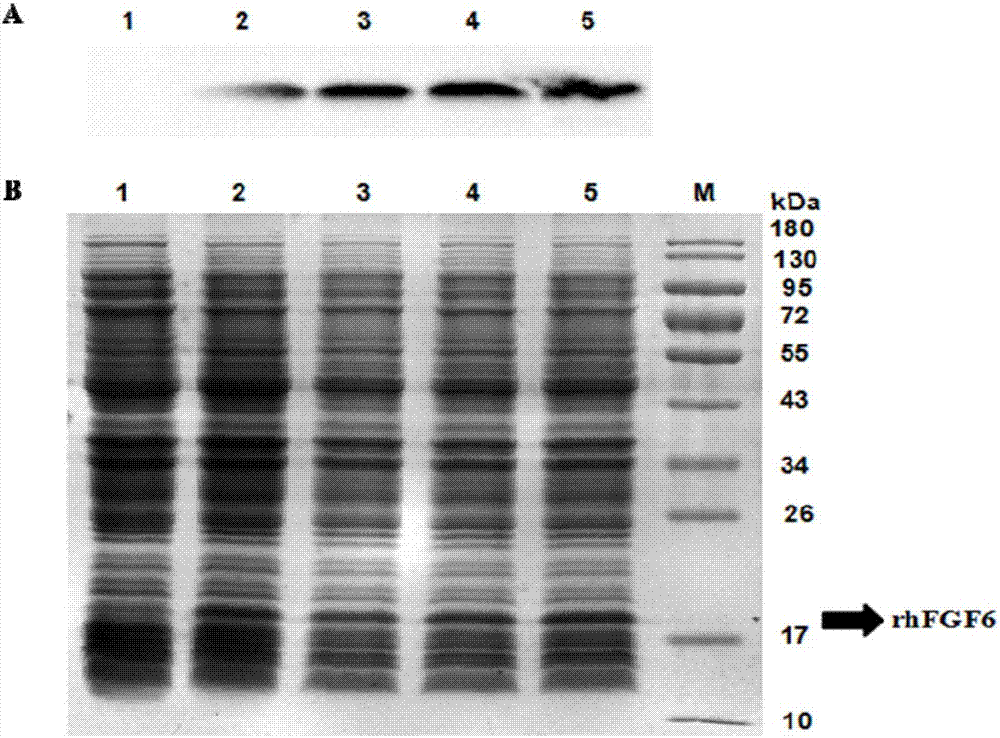Nucleic acid fragment for encoding rhFGF-6, expression vector, host cell, production method and application
A technology for expressing vectors and nucleic acid fragments, applied in the field of nucleic acid fragments encoding rhFGF-6, which can solve the problems of low activity of rhFGF-6 and difficulty in meeting large-scale applications, so as to promote muscle tissue regeneration, wound healing, and angiogenesis Effect
- Summary
- Abstract
- Description
- Claims
- Application Information
AI Technical Summary
Problems solved by technology
Method used
Image
Examples
Embodiment 1
[0066] This embodiment provides a nucleic acid fragment encoding rhFGF-6.
[0067] The nucleotide sequence of the nucleic acid fragment is shown in SEQ ID NO.1. The sequence is codon-optimized from the natural sequence of human FGF-6 (as shown in SEQ ID NO.2) according to the preference of Escherichia coli, 37 signal peptides are removed, and the secondary structure that is not conducive to expression is eliminated, but it does not change Amino acid sequence of FGF-6.
[0068] The nucleic acid fragment provided in this example is constructed into an expression vector, and the recombinant expression vector is transformed into a host cell to obtain a recombinant bacterium, which is cultured and induced to express with an inducer to obtain high expression of rhFGF-6.
Embodiment 2
[0070] The present embodiment provides a method for producing rhFGF-6, comprising the steps of:
[0071] 2.1 Construction of recombinant expression vector
[0072] Synthesize the rhFGF-6 gene, introduce a start codon and a stop codon at the 5' end and 3' end of the nucleic acid fragment encoding rhFGF-6 (SEQ ID NO.1), and introduce specific enzyme cutting sites NdeI and BamHI.
[0073] The expression vector pET3a and rhFGF-6 genes were treated with NdeI and BamHI double enzyme digestion at 37°C, respectively, and digested for 4 hours.
[0074] The corresponding restriction fragments were recovered and ligated overnight at 16°C with T4 DNA ligase to construct a recombinant expression vector. pET3a-rhFGF-6 recombinant expression vector figure 1 shown.
[0075] 2.2 Transformation and identification of recombinant expression vector
[0076] The recombinant expression vector pET3a-FGF-6 was transformed into the host cell: Escherichia coli BL21(DE3) plysS, positive clones were ...
Embodiment 3
[0118] The present embodiment provides a method for producing rhFGF-6, comprising the steps of:
[0119] Construction of expression vectors, transformation and identification of recombinant expression vectors, cultivation of recombinant bacteria, induction of rhFGF-6 expression, collection and disruption of bacteria, cleaning and denaturation of inclusion bodies are basically the same as the steps and methods provided in Example 2, the difference In this example, the induction culture conditions in this embodiment are: the lactose concentration is maintained at 30 mM, the temperature is 34° C., and the pH is 7.0. In addition, the method for producing rhFGF-6 provided in this embodiment also includes:
[0120] 3.1 Refolding of inclusion bodies
[0121] Take the inclusion body denaturation solution, put it into a dialysis bag with a molecular weight cut-off of 7KD, put in 50 times (v:v) refolding buffer (20mM PB, 2mM EDTA-2Na, 0.1M NaCl , 1% Triton X-100, 5mMDTT, pH7.3), oxidi...
PUM
| Property | Measurement | Unit |
|---|---|---|
| molecular weight | aaaaa | aaaaa |
Abstract
Description
Claims
Application Information
 Login to View More
Login to View More - R&D Engineer
- R&D Manager
- IP Professional
- Industry Leading Data Capabilities
- Powerful AI technology
- Patent DNA Extraction
Browse by: Latest US Patents, China's latest patents, Technical Efficacy Thesaurus, Application Domain, Technology Topic, Popular Technical Reports.
© 2024 PatSnap. All rights reserved.Legal|Privacy policy|Modern Slavery Act Transparency Statement|Sitemap|About US| Contact US: help@patsnap.com










